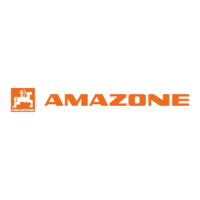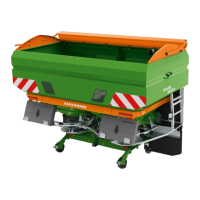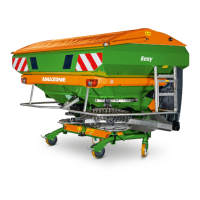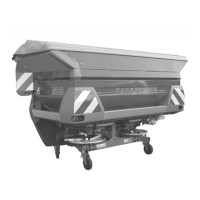
Do you have a question about the Amazone ZG-B 5500 Special and is the answer not in the manual?
Manufacturer's contact and location information.
Information on how to order spare parts and where to find lists.
Details about document number, compilation date, and copyright.
Explains the manual's purpose and its importance.
Clarifies how directions are given within the manual.
Explains conventions used in diagrams and lists.
Outlines operator and user obligations and liability concerning safety.
Lists potential risks and restrictions encountered during machine operation.
Excludes liability for damages traced back to specific causes like improper use.
Explains the meaning and severity levels of different safety symbols.
Details necessary personal protective equipment and manual accessibility.
Emphasizes checking safety equipment's attachment and functionality before operation.
Stresses compliance with general regulations and road traffic laws.
Defines requirements for personnel operating and maintaining the machine.
Covers daily checks and functional verification of safety equipment during operation.
Warns about residual mechanical, hydraulic, pneumatic, and electrical energy.
Guides on performing maintenance, securing media, and checking safety devices.
Prohibits unauthorized modifications and specifies approval requirements.
Mandates the use of genuine AMAZONE parts for type approval and liability.
Advises on careful handling and disposal of materials, especially lubricants and solvents.
Specifies that the machine is operated by one person in the tractor's seat.
Explains the importance of clean and legible warning symbols on the machine.
Illustrates the placement of various warning symbols on the machine.
Lists consequences of ignoring safety information, including warranty loss.
Stresses adherence to national safety regulations and warning symbols.
Provides warnings and safety advice for the tractor operator.
Covers general safety, warning symbols, and pre-operation checks.
Details safety precautions for working with the hydraulic system due to high pressure.
Outlines safety measures when working with the machine's electrical system.
Advises on permitted combinations and drawbar load limits.
Covers safety for pneumatic and hydraulic brake systems, including specialist work.
Details safety for tyre repair, pressure checks, and secure parking.
Warns about danger from flying particles and safe filling procedures.
Emphasizes using guards, checking PTO speed, and safety during installation/removal.
Specifies safety for performing cleaning, maintenance, and repair work.
Details warnings and instructions for loading/unloading using a tractor.
Explains safe lifting procedures using a crane and attachment points.
Presents a labeled diagram showing the main components of the machine.
Identifies and illustrates various safety guards and protective features on the machine.
Shows and identifies the various hydraulic, electric, and brake lines.
Details the lighting and reflector components for transportation.
Describes the machine's design purpose and forbidden uses, including on sloping terrain.
Defines the machine's danger zones and specific danger points.
Explains the information found on the EU and machine rating plates and CE marking.
Lists specifications like hopper size, dimensions, tyre options, and drive types.
Explains payload calculation, axle/drawbar loads, and the role of tyre load capacity.
Specifies required tractor power, electrical, hydraulic, and brake connections.
States the measured noise level at the operator's ear.
Provides a diagram with numbered components and their names.
Explains the components and function of the air-pressure brake system.
Details the procedure for correctly coupling pneumatic brake systems.
Outlines the correct procedure for uncoupling pneumatic brake systems.
Explains the tractor's requirement for hydraulic braking equipment.
Describes the process of connecting clean hydraulic couplings.
Details how to disconnect hydraulic service brake system couplings.
Explains how the emergency brake functions when the machine is released from the tractor.
Explains the function and operation of the parking brake.
Describes the function of the overrun brake and its pulling cable.
Explains the use and parking position of the foldable wheel chocks.
Specifies the requirement for safety chains on implements without brakes.
Mentions a lockable device to prevent unauthorized use.
Describes the types of drawbars and height adjustability.
Explains the use of colored markings and tractor control units for hydraulic functions.
Details the procedure for connecting hydraulic hose lines, emphasizing cleanliness.
Outlines the steps for safely disconnecting hydraulic hose lines.
Introduces the Hyclick system for operating hydraulic functions.
Explains the PTO shaft's function and provides critical safety warnings.
Provides step-by-step instructions for safely coupling the PTO shaft.
Details the procedure for safely uncoupling the PTO shaft.
Explains how to adjust the quantity of spread material using the main shutter slide.
Describes the operation and commissioning/decommissioning of the double shutter.
Explains the use of the chain rake for spreading lime and bone meal.
Details the assembly and removal procedure for a removable chain rake.
Explains how to put a chain rake mounted on a double shutter into operation.
Explains how to spread granular fertilizer using OM discs and funnel chute.
Details spreading lime using lime spreading discs and the deflector guide.
Describes spreading granulated fertilizer using lime discs and the roof chute.
Explains spreading bone meal and safety warnings for colliding vanes.
Mentions a holder for carrying extra spreading discs.
Explains how to use the Limiter for boundary and side spreading.
Describes the conveyor belt's function and drive types.
Details belt conveyor drive systems for ZG-B Special/Super and ZG-B Drive.
Explains the ground wheel drive system for ZG-B Super and its tensioning.
Describes the foldable ladder and safety warning for transport.
Details how to raise and lower the machine's stand, including gear options.
Explains how to insert or remove sieve screens for different fertilizer types.
Describes the optional swivelable hopper cover and its operation.
Provides a safety warning regarding the use of the camera system for maneuvering.
Recommends using the fertilizer database and explains its purpose for settings.
Details the ZG-B Drive system components and operation.
Explains the function of the AMATRON 3 terminal for controlling the ZG-B Drive.
Describes the hydraulic control block and machine computer, including the oil filter.
Explains how TrailTron ensures precise tracking by monitoring drawbar position.
Details the weighing system for tank volume and application rate monitoring.
Describes the procedure for emptying and taring the weighing equipment.
Provides a diagram of the weighing terminal's menu structure and key functions.
Introduces the AMALOG+ system for hectare counting and its components.
Describes the AMALOG+ computer, connection, and data storage.
Explains how to set the worked area to zero and view work data.
Details the steps for connecting and installing the AMALOG+ terminal.
Guides on selecting hectare counter mode and entering working width.
Explains the need for a calibration value and how to enter it manually.
Describes EasyCheck as a digital test rig for checking lateral distribution.
Explains the mobile test rig for checking lateral distribution and its evaluation methods.
Emphasizes checking tractor suitability and performing a brake test.
Details how to calculate weight distribution and minimum ballast requirements.
Lists parameters needed for calculating tractor weight and load capacities.
Provides the formula for calculating minimum front ballast for steering.
Gives the formula for calculating the actual front axle load.
Provides the formula for calculating the combined tractor and machine total weight.
Gives the formula for calculating the actual rear axle load.
Instructs on entering the approved load capacity for tyres.
Presents a table for comparing calculated values with approved tractor specifications.
Lists requirements for tractor operation with attached equipment, focusing on load limits.
Shows permitted combinations of tractor and implement coupling devices.
Explains how to compare calculated DC values with permissible limits for safety.
Specifies requirements for machines without brakes, including tractor weight and speed limits.
Warns about PTO shaft adjustment and recommends specialist checks for proper length.
Details critical steps to prevent unintentional movement during maintenance.
Provides instructions for assembling and fitting wheels, including torque specifications.
Recommends performing brake tests when empty and loaded.
Explains how to adjust the drawbar height using spacer discs.
Guides on adjusting the hydraulic system using the setting screw, warning about oil temperature.
Explains how to fit the holder and position encoder for TrailTron system.
Provides warnings and guidance for safely coupling the machine to the tractor.
Details safety precautions and steps for uncoupling the machine from the tractor.
Explains how to manoeuvre the machine with the service brake released and braking requirements.
Explains how to set the spread rate via floor belt speed or spreading table.
Guides on using the setting chart to find fertilizer trade names, bulk density, and shutter positions.
Explains how to use a sliding ruler to determine shutter position based on fertilizer properties.
Details how to set the spread rate by adjusting the main shutter slide position.
Explains how to set belt speed on the shift gearbox for ZG-B Special/Super.
Covers checking and calibrating spread rate control for mineral fertilizer.
Details the setup for performing a spread rate check using calibration devices.
Explains how to check spread rate by driving a test distance and using conversion tables.
Describes how to perform a spread rate check while the machine is stationary.
Explains how to set the working width by selecting appropriate spreading disc pairs.
Details how working width is adjusted via spreading disc pairs and fertilizer properties.
Guides on adjusting spreading vane positions based on working width and fertilizer type.
Covers checking and optimizing working width and lateral distribution using test rigs.
Explains how to perform late top dressing by swiveling spreading disc blades.
Details how to adjust the funnel chute for different spread rates.
Explains procedures for boundary, ditch, and side spreading according to fertilizer ordinances.
Explains setting the Limiter based on boundary distance, fertilizer type, and field conditions.
Details checking and cleaning guide chute outlet openings for proper spread pattern.
Provides warnings for filling and instructions for removing residues.
Explains how to empty the machine while stationary, including safety precautions.
Details spreading operation with OM discs, including vane wear and safety warnings.
Provides guidance for accurate spreading on field boundaries and edges.
Addresses non-uniform fertilizer distribution due to disc/vane issues or fertilizer properties.
Deals with incorrect measurements in the spreader unit requiring checks.
Describes issues with too much fertilizer in the tractor track due to speed or worn parts.
Addresses too much fertilizer in the overlap area due to excessive spreading disc speed.
Covers problems like floor belt not conveying, slipping, or being parallel.
Addresses potential collision between PTO shaft and towing eye due to tractor geometry.
Deals with the swivelable hopper cover not opening or opening too fast.
Covers issues like no hydraulic functions, high fluid temperature, and overheating.
Addresses power supply issues causing the AMATRON 3 to show no function.
Provides general cleaning guidelines and specific instructions for using pressure washers.
Shows lubrication points and specifies types of lubricants to use.
Details lubrication of brake shaft bearings and adjustment of linkage systems.
Explains the process of renewing wheel hub bearing grease and checking for wear.
Covers brake pad checks, linkage adjuster adjustment, and slack adjuster function.
Explains the need for greasing PTO shaft guard tubes in winter.
Provides a schedule for maintenance tasks based on operating hours.
Details the procedure for removing and installing spreading discs, including safety warnings.
Explains the importance of spreading vanes and the need for replacement when worn.
Guides on replacing spreading vanes, emphasizing nut replacement and correct installation.
Details replacing swivel vanes, stressing the use of new nuts and assembly paste.
Explains the function of automatic belt control and how to tension the conveyor belt.
Outlines checks for damage, wear, and tightening of fastening bolts for coupling devices.
Covers recommendations for brake balancing and general visual inspection of the brake system.
Details checking brake drums for dirt and wheel hub bearing play.
Explains the steps to adjust wheel bearing play if detected.
Covers brake pad checks, linkage adjuster adjustment, and slack adjuster function.
Details the procedure for adjusting the S3008 RAZG expanding lever brake.
Explains daily draining of the air reservoir and changing line filter inserts.
Provides detailed inspection steps for the dual circuit service brake system.
Covers readjusting parking brake cables and checking braking effect.
Details required torque for wheel nuts, tyre pressure, and general checks.
Explains how to inflate tyres to the nominal pressure.
Provides instructions for fitting tyres, including rim seating and valve caps.
Warns about infection risks from high-pressure hydraulic fluid and first-aid measures.
Explains the information provided on assembly labels for hydraulic hoses.
Outlines maintenance intervals for hydraulic systems and hose line checks.
Lists criteria for inspecting hydraulic hose lines for damage and wear.
Provides guidelines for installing and removing hydraulic hose lines, emphasizing cleanliness and proper routing.
Details the correct procedure for mounting hose fittings with O-rings and sleeve nuts.
Explains how to check and replace the hydraulic fluid filter.
Describes how to flush solenoid valves to remove impurities.
Lists fill levels for various gearbox components.
Provides instructions for replacing defective light bulbs.
Provides a table of screw tightening torques for various bolt sizes and grades.











